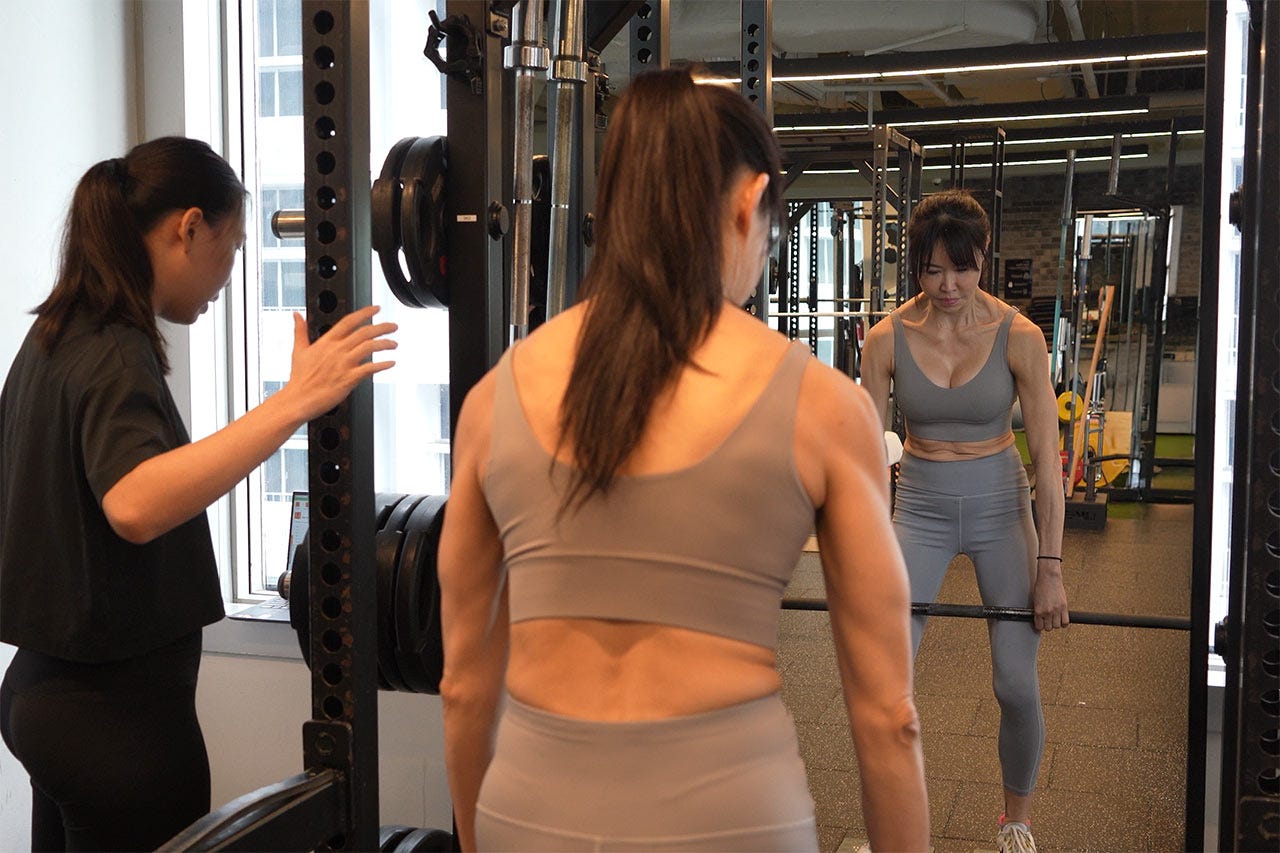Strength assessments are gaining mainstream popularity; I wrote about the three most popular use cases in a previous article.
Here, I elaborate on what strength assessments look like.
Specifically, I feature five common tests in a strength assessment battery.
Isometric mid-thigh pull
Countermovement jump
Drop jump
Single leg jump
Push up
For context, upcoming articles for this series include:
What does a strength assessment for seniors look like?
What does a strength assessment for runners look like?
Please check them out if they are also relevant to you.
Strength Assessment Equipment
A quick note before we proceed:
For this article, I share demonstrations from assessment equipment manufacturers, VALD, of which I am a user.
However, this article is not sponsored by them and there are other options in the market to help conduct these test.
The common theme among manufacturers is that the equipment’s sensors measure precise metrics, e.g. rate of force development to the millisecond, to give you actionable insights.
Isometric Mid-Thigh Pull: Measures Full Body Maximum Strength and Power
The Isometric Mid-Thigh Pull (IMTP) is a multi-joint exercise test designed to assess whole-body strength and force production capabilities.
It requires individuals to pull on a fixed barbell with maximal effort for a short duration (typically 3-5 seconds) while standing on force plates.
Strength is a useful metric in use cases like tracking athletic performance and rate of age-related decline.
The IMTP has many advantages compared to traditional one-rep-max tests, i.e. technical simplicity, safety, better data, less time to conduct, etc.
Countermovement Jump: Measures Your Explosive Strength
The countermovement jump (CMJ) is one of the most common strength assessment worldwide as it offers insights into an athlete’s explosive strength, neuromuscular efficiency, and overall functional capacity.
The CMJ is often used for athletic performance monitoring, fatigue monitoring, training effectiveness, injury risk assessment, etc.
Some of the metrics measured include jump height, peak force, leg stiffness, and duration of different jump phases.
One of the top use cases is to measure power, which is highly correlated with mortality risk and sports performance.
Drop Jump: Measures Your Reactive Strength
Drop jumps (DJ), as compared to countermovement jumps, provide unique measurements for another form of strength like:
Reactive Strength Index (RSI) - measures an athlete’s ability to rapidly transition from eccentric to concentric contraction
Ground contact time - indicates reactive capabilities and neuromuscular efficiency
A jump height that reflects power production capacity utilising high stretch velocity and a faster stretch shortening cycle (compared to CMJ which employs a slower cycle)
Single Leg Jump: Measures Single Leg Function
Single leg jump (SLJ) is one of the unilateral movement assessments that provide insights into lower limb function, asymmetries, and performance capabilities.
They differ from bilateral assessments like CMJs and DJs and can provide further strength insights.
For example, it helps you understand how the body coordinates complex movement patterns and absorbs landing forces on a single leg.
Push Up: Measures Upper Body Maximum Strength
The force deck push up test has significant correlations with traditional bench press one-repetition maximum (1RM) testing.
It offers an alternatives for upper body strength assessment which is quicker to administer, involves lesser technique training, has lesser injury risk, and provides more insightful metrics.
Conclusion
There are more than a thousand strength assessments apart from those mentioned above because of:
different metrics to measure - strength, power, range of motion, etc.
different body parts to measure - toe, hip, shoulder, etc.
different movements to measure - isolated, compound, change of direction, etc.
Assessment professionals help customise the test based on your goals, especially if we keep ourselves updated in the fast developing field.
To that point, my team has partnered with Danny Lum, PhD, the head of strength and conditioning at Singapore Sports Institute with more than eight years of research and practice experience on the topic, to conduct courses.
If you would like to explore a strength assessment with my team, please reach out.
References
Van Den Tillaar, R., & Ball, N. (2020b). Push-Ups are Able to Predict the Bench Press 1-RM and Constitute an Alternative for Measuring Maximum Upper Body Strength Based on Load-Velocity Relationships. Journal of Human Kinetics, 73(1), 7–18. https://doi.org/10.2478/hukin-2019-0133
Dobbs, I. (2025, March 17). Isometric Mid-Thigh Pull (IMTP). Science for Sport. https://www.scienceforsport.com/isometric-mid-thigh-pull-imtp/
Dos’Santos, T., Thomas, C., Comfort, P., McMahon, J. J., & Jones, P. A. (2017). Relationships between Isometric Force-Time Characteristics and Dynamic Performance. Sports, 5(3), 68. https://doi.org/10.3390/sports5030068
Understanding the countermovement jump. (2024b, March 12). https://valdperformance.com/news/understanding-the-countermovement-jump
Donahue, P. T., Wilson, S. J., Williams, C. C., Hill, C. M., & Garner, J. C. (2021). Comparison of countermovement and squat jumps performance in recreationally trained males. International Journal of Exercise Science, 14(1). https://doi.org/10.70252/fxqb8485
Anicic, Z., Janicijevic, D., Knezevic, O. M., Garcia-Ramos, A., Petrovic, M. R., Cabarkapa, D., & Mirkov, D. M. (2023). Assessment of countermovement jump: What should we report? Life, 13(1), 190. https://doi.org/10.3390/life13010190
Montoro-Bombú, R., Sarmento, H., Buzzichelli, C., Moura, N. A., Badillo, J. J. G., Santos, A., & Rama, L. (2023). Methodological considerations for determining the volume and intensity of drop jump training. A systematic, critical and prepositive review. Frontiers in Physiology, 14. https://doi.org/10.3389/fphys.2023.1181781
Fu, H., Li, Z., Zhou, X., Wang, J., Chen, Z., Sun, G., Sun, J., Zeng, H., Wan, L., Hu, Y., Wang, F., & Zheng, J. (2023). The profiles of single leg countermovement jump kinetics and sprinting in female soccer athletes. Heliyon, 9(8), e19159. https://doi.org/10.1016/j.heliyon.2023.e19159
Pérez-Castilla, A., García-Ramos, A., Janicijevic, D., Miras-Moreno, S., De La Cruz, J. C., Rojas, F. J., & Cepero, M. (2021). Unilateral or Bilateral Standing Broad Jumps: Which Jump Type Provides Inter-Limb Asymmetries with a Higher Reliability? Journal of Sports Science and Medicine, 317–327. https://doi.org/10.52082/jssm.2021.317
Dami, A., Payen, E., Isabelle, P., Farahpour, N., & Moisan, G. (2025). Comparative analysis of lower limb biomechanics during unilateral drop jump landings on even and medially inclined surfaces. PLoS ONE, 20(5), e0322562. https://doi.org/10.1371/journal.pone.0322562
Wang, L. (2011, March 1). The lower extremity biomechanics of single- and Double-Leg Stop-Jump tasks. https://pmc.ncbi.nlm.nih.gov/articles/PMC3737885/




